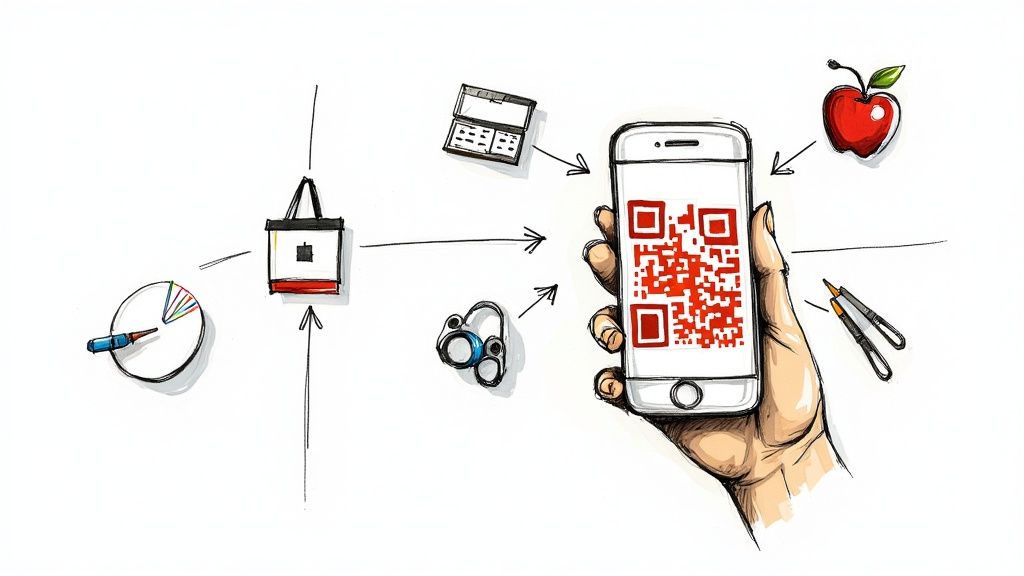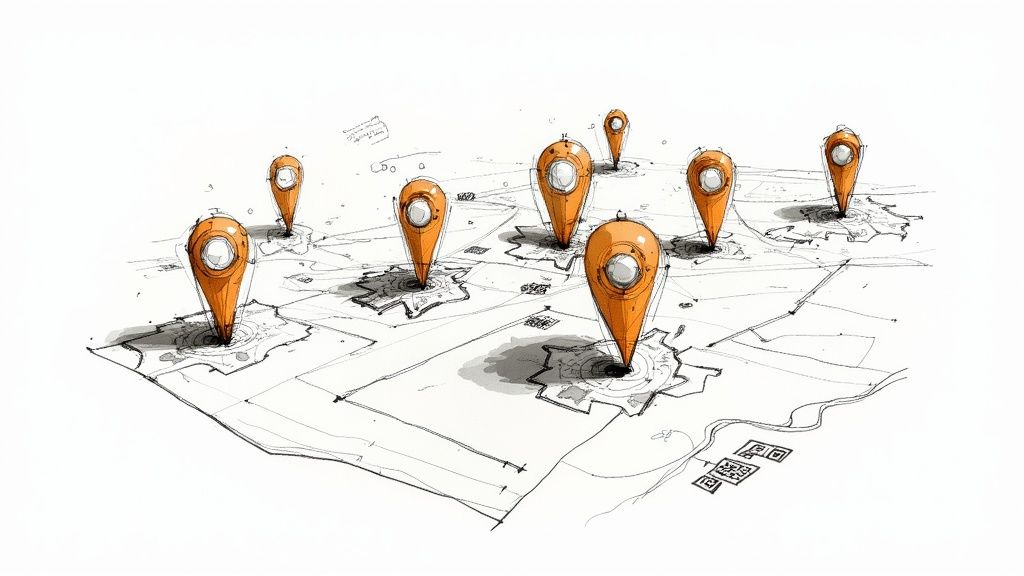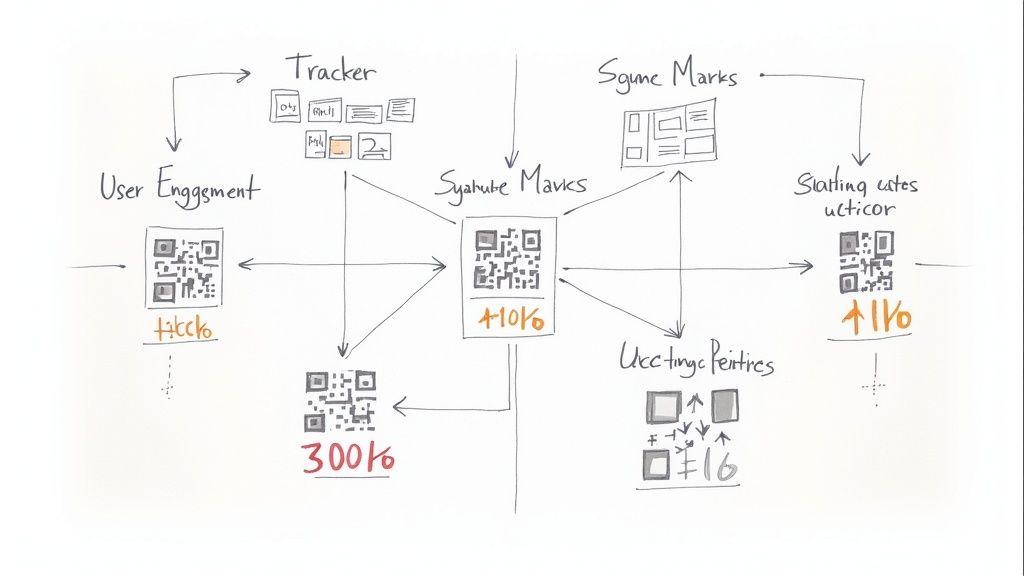QR Code Marketing Strategies: A Complete Guide to Digital-Physical Integration
qr code marketing strategies
- 9 min read

Understanding the QR Code Marketing Revolution

QR codes create a direct link between physical materials and online content. When businesses add QR codes to their packaging, signage, and marketing materials, they open up new ways to connect with customers. This simple technology helps bridge offline and online experiences in ways that feel natural and convenient.
Why QR Codes Are Essential for Modern Marketing
QR codes give customers instant access to digital content right from physical materials. A quick scan with a smartphone can pull up product details, demonstration videos, special offers, and more. This removes friction and helps customers get the information they need exactly when they want it.
Many businesses are finding creative ways to use QR codes. Restaurants place them on tables for easy menu access and ordering. Retail stores add them to product displays so shoppers can read reviews and compare options. The technology adapts to fit different business needs while making things simpler for customers.
Recent data shows QR codes are becoming a standard marketing tool, with a 323% jump in QR code creation since 2021. More businesses recognize how QR codes help them connect with mobile-first customers. For more details on adoption trends, check out these QR code usage statistics.
Key Benefits of QR Code Marketing
Adding QR codes to your marketing brings several clear advantages:
- Better Customer Engagement: Give people quick access to useful content, deals, and interactive features right when their interest peaks
- More Website Traffic: Direct foot traffic to your online presence through strategic QR code placement
- Measurable Results: Track scan data to understand which locations and materials perform best
- Personal Touch: Customize the content people see based on when and where they scan
- Connected Experience: Link your physical marketing smoothly with your digital presence
QR codes are now an expected part of the customer experience. They've evolved from a novelty into an essential marketing tool that helps businesses meet customers where they are - on their phones. With most people carrying smartphones, QR codes offer a practical way to enhance traditional marketing with digital capabilities.
Measuring Success: ROI and Analytics in QR Marketing
Understanding how well your QR codes perform is essential for any marketing strategy. Creating codes is just the first step - you need clear data about their impact. By setting up proper tracking and monitoring Key Performance Indicators (KPIs), you can make smart decisions about your campaigns and measure their Return on Investment (ROI).
Setting Up Tracking and Attribution
The first step is putting tracking systems in place. Unlike basic static codes, dynamic QR codes let you change destination URLs and provide built-in analytics. This means you can see scan data in real-time and understand exactly how people interact with your codes. Dynamic codes also make it much easier to connect specific user actions back to your campaigns, so you know which placements drive the most engagement.
Essential KPIs for QR Code Campaigns
While total scan count gives you a basic view, looking at more specific metrics reveals deeper insights. For example, conversion rate shows what percentage of scans lead to desired actions like purchases or sign-ups. Here are key metrics to track:
- Unique Scans: Shows how many different people scanned your code, filtering out repeat scans
- Scan Location: Helps you understand where people engage with your codes most often
- Scan Time: Shows the peak times when users scan your codes
- Device Type: Tells you what devices people use, so you can optimize the experience
These data points work together to show how well your campaigns perform and where you can improve.
Calculating ROI and Demonstrating Value
QR codes help businesses connect print and digital marketing while gathering detailed performance data. This makes it straightforward to calculate ROI by tracking metrics like total scans, conversions, and revenue. Learn more about measuring QR code ROI here. For example, to calculate lead generation ROI, subtract your marketing costs from the revenue those leads generated, then divide by the marketing cost.
Using Real-Time Analytics for Optimization
Real-time data lets you adjust campaigns quickly based on performance. If a QR code isn't getting many scans in one location, you can move it or redesign it. You can also test different versions of your codes, calls-to-action, and landing pages to see what works best. By watching the data and making improvements, you'll get better results over time.
Using this measured approach helps businesses understand exactly how their QR codes perform, improve their campaigns, and create better experiences for customers. Making decisions based on real data is essential for getting the most from QR code marketing.
Global Trends and Consumer Behavior in QR Adoption

QR codes have become a key way for businesses to connect with customers, driven by widespread smartphone use and better internet access. Understanding how people use QR codes helps create marketing campaigns that really work.
Regional Differences in QR Code Usage
QR code adoption looks very different across the world. In China, QR codes are woven into everyday life - people use them for payments, messaging, and more. Meanwhile, other regions mainly see QR codes in marketing materials and promotions. These regional differences show why it's important to adjust your QR campaigns based on local habits.
Consumer Preferences and Motivations
What makes someone scan a QR code? It comes down to value and convenience. People scan when they expect something worthwhile - like a special discount or exclusive content. But if scanning seems difficult or the benefit isn't clear, they'll likely skip it. That's why clear instructions and smooth user experience matter so much. For more tips on improving customer engagement, check out How to master customer reviews.
Mobile Device Usage and QR Code Scanning
More people owning smartphones means more QR code scanning. Current data shows that 44.6% of internet users aged 16-64 scan QR codes monthly. Experts predict this will grow 22% by 2025. With 4.88 billion smartphone users worldwide in 2024, QR marketing can reach huge audiences. The U.S. leads with 42.2% of global scans, followed by India, France, Canada and the UK. Learn more about usage trends at QR Code Statistics.
Adapting to Diverse Audiences
Smart QR marketing considers cultural differences, from language to design preferences. A campaign that works for tech-savvy young adults may need adjustments for older audiences. The key is staying flexible with your approach.
Optimizing for Various Markets
Your QR strategy should match local conditions. Consider factors like:
- Available technology and internet access
- How people typically use their phones
- Local cultural preferences and habits
Simple, direct campaigns often work best in areas with lower smartphone use, while markets with high tech adoption allow for more complex features. The goal is making your QR codes useful and relevant, no matter where your audience is located.
Modern Marketing: Where QR Codes Meet Advanced Technology
QR codes are no longer just simple black and white patterns. Smart companies are mixing QR codes with other tools to create more interesting marketing campaigns. By adding extra tech features, QR codes can do much more than before.
Blending QR Codes With AI, AR, and IoT
Artificial Intelligence (AI) makes QR codes smarter by creating custom experiences. When someone scans a code, they get content picked just for them based on what they like. Augmented Reality (AR) adds visual magic - scan a QR code and see a product in 3D before buying it. The Internet of Things (IoT) connects QR codes to real objects, showing live information that customers can use.
QR Codes + Blockchain: More Trust, Better Tracking
Blockchain technology makes QR codes more secure and honest. This helps prove products are real, track where they came from, and manage customer rewards. When customers scan a QR code linked to blockchain, they know exactly what they're getting - great for fighting fake products.
Making Messages Personal at a Large Scale
QR codes really shine when they create personal experiences for lots of people at once. Adding QR codes to direct mail with custom printing makes campaigns work better. Each person gets their own QR code leading to a page made just for them. This makes marketing feel more personal and meaningful. Want to learn more about QR codes in print? Check out this guide to QR codes in print marketing. Need a QR code? Try our free QR code generator.
Making It Work in Real Life
While fancy tech features are great, keeping things running smoothly matters most. Pick tech tools based on what you want to achieve and who you want to reach. Think about how hard it will be to set up, what skills you'll need, and what results you can expect. Good planning helps your QR campaigns work better without wasting time or money.
Picking the Right Tech Tools
You don't need to use every new technology out there. Smart QR code marketing means choosing tools that fit your goals and customers. Start by asking what you want to achieve - more engagement? Better sales? More brand awareness? This helps you pick the right tech tools.
For instance, if you sell products, AR might be perfect for showing them off. If you care about trust and being eco-friendly, blockchain could help prove your claims. This focused approach keeps your marketing clear and effective.
Creating High-Impact QR Campaign Strategies

A successful QR code campaign needs smart planning to really connect with customers. Let's explore how to build campaigns that get results through smart placement, clear design, and strong calls to action.
Strategic QR Code Placement: Maximizing Visibility and Engagement
Where you put your QR code makes a huge difference in how many people scan it. Choose spots where your target audience naturally spends time and can easily scan the code. Some effective locations include:
- Product packaging
- Store displays and signage
- Restaurant menus
- Purchase receipts
- Event materials
The placement should make sense for what the code links to. For example, a QR code on product packaging works best when it leads to product details or usage instructions. At checkout, codes that offer loyalty program signup or future discounts tend to perform well. Want more placement ideas? Check out How to Get Online Reviews with QR Codes.
QR Code Design: Balancing Aesthetics and Scannability
While visual appeal matters, a QR code needs to work smoothly above all else. Keep these design tips in mind:
- Use high contrast colors for easy scanning
- Add your logo or brand colors subtly
- Include white space around the code
- Test the code thoroughly on different devices
- Make sure the code is large enough to scan easily
Compelling Calls to Action: Driving Conversions
Tell people exactly why they should scan your code. Instead of leaving the QR code unexplained, add clear text that highlights the benefit, such as:
- "Scan for 20% off your next purchase"
- "Scan to see product demo videos"
- "Scan to join our rewards program"
Make sure the landing page matches what you promised. If you offer a discount, the code should take users directly to that offer - not just your homepage.
Testing and Optimization: Refining Your QR Code Strategy
Track how your QR codes perform and make improvements based on real data. Key things to measure include:
- Number of scans per location/placement
- Conversion rate from scans to desired actions
- Time of day and day of week when codes get the most use
- User feedback about the scanning experience
Run A/B tests with different placements, designs and calls to action. Use what you learn to keep improving your QR code campaigns over time.
Future-Proofing Your QR Marketing Strategy

QR code marketing continues to grow and change. Keeping up with new developments and adopting fresh approaches helps businesses get better results from their QR campaigns. Here's how to make your QR code marketing work better both now and in the future.
Smart Tech Integration
New technologies can make QR codes more powerful. Augmented Reality (AR) paired with QR codes lets users see 3D product demos and interactive content right on their phones. AI helps deliver personalized experiences based on each user's scan history and preferences.
Blockchain technology makes QR codes more secure and trustworthy, especially for tracking products and proving authenticity. These additions give users a better experience while providing businesses with helpful data about how people interact with their QR codes.
Meeting User Needs
People expect quick and simple experiences when they scan QR codes. The content they see needs to load fast, work well on phones, and give them exactly what they're looking for.
Getting user feedback helps improve QR campaigns. Add simple ways for customers to rate content or suggest changes. This input helps make future scans work better for everyone.
Spotting New Opportunities
Being among the first to try new QR code features can set your business apart. Watch what works for other companies and stay current with industry trends through events and professional networks.
Connect with other marketers and tech experts to learn about upcoming QR code capabilities. This helps you make smart choices about which new features to add to your campaigns.
Keeping Plans Flexible
Your QR strategy needs room to grow and change. Here's how to stay adaptable:
- Use dynamic QR codes that let you update linked content without creating new codes
- Check how well your current QR campaigns perform and adjust based on results
- Work with partners in different industries to find fresh ways to use QR codes
A solid QR marketing plan combines these approaches to deliver better results. For businesses wanting to gather and showcase customer feedback effectively, kisReviews provides tools to make the process simple.
Try kisReviews to keep your QR marketing current and effective.
